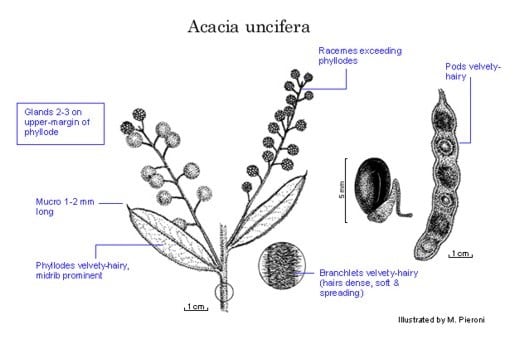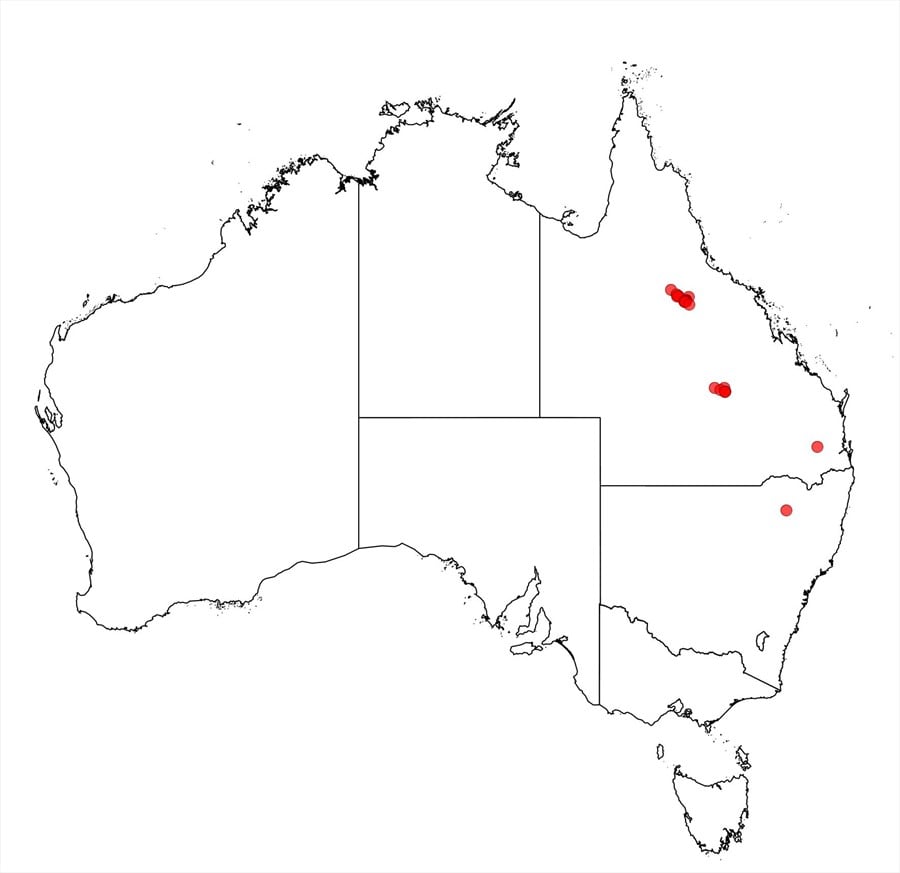Acacia uncifera Benth.
WATTLE
Acacias of Australia
Family
Fabaceae
Distribution
Known only from the White Mtns, Pentland–Torrens Ck area and the headwaters of the Nogoa R. (type locality, c. 550 km S of Pentland), Qld.
Description
Straggly or willowy shrub or tree 2–5 m high. Branchlets velvety pubescent with dense soft spreading hairs 0.5–1 mm long. Phyllodes patent to erect, narrowly oblong to narrowly elliptic, sometimes oblanceolate, (1.7–) 2–5 (–6) cm long and 6–17 mm wide with l:w = 3–5, with 1–2 mm long, ±incurved or inflexed mucro, ±thinly coriaceous, green, velvety pubescent, with prominent midrib, obscurely penninerved; glands 2 or 3, with the lowermost 1–5 mm above pulvinus; pulvinus c. 2 mm long. Inflorescences 10–20-headed racemes; raceme axes 5–8 cm long, exceeding phyllodes, rather stout and pubescent; peduncles (3–) 4–7 mm long, pubescent; heads globular, 25–30-flowered, bright golden. Flowers 5-merous; sepals 2/3–3/4-united. Pods variably constricted between seeds, to 6.5 cm long, 6–11 mm wide, thinly coriaceous, velvety. Seeds oblique to almost transverse, elliptic, obliquely truncate adjacent to aril, 4–5 mm long, dull to slightly shiny, black.
Habitat
Grows on sandstone in Eucalyptus –Angophora low open forest or woodland.
Specimens
Qld: 29 km W of Pentland, A.D.Chapman 1372 (BRI); Spyglass Peak, Salvator Rosa Natl Park, M.E.Ballingall 2170 (BRI, PERTH).
Notes
Seems most closely related to A. podalyriifolia which has pruinose branchlets, commonly broader, usually silvery grey to glaucous phyllodes with a single gland further removed from pulvinus, and broader pods with larger seeds. There are also subtle indumentum differences, fide L.Pedley, Austrobaileya 1: 277 (1980). Specimens with patent phyllodes may be reminiscent of A. leichhardtii which has narrower, usually less hairy phyllodes with solitary glands (sometimes absent) and longitudinal seeds encircled by the funicle.
The type locality is a considerable distance from the main area of occurrence of the species, fide L.Pedley, Austrobaileya 1: 277 (1980). Furthermore, the peduncles on the type specimen are only 3 mm long.
FOA Reference
Data derived from Flora of Australia Volumes 11A (2001), 11B (2001) and 12 (1998), products of ABRS, ©Commonwealth of Australia
Author
B.R.Maslin
Minor edits by J.Rogers
This identification key and fact sheets are available as a mobile application:
URL: https://apps.lucidcentral.org/wattle/
© Copyright 2018. All rights reserved.








